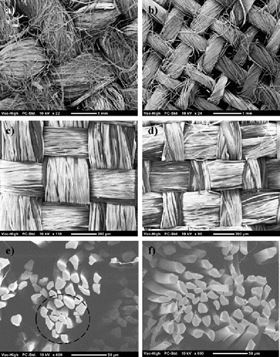 SEM images of the plain weave textiles: (a) flax, (b) hemp, (c) silk A, and (d) silk B. SEM images of cross-sections of silk rovings and fibres in (e) and (f).
SEM images of the plain weave textiles: (a) flax, (b) hemp, (c) silk A, and (d) silk B. SEM images of cross-sections of silk rovings and fibres in (e) and (f).While it is common knowledge in natural fibre composites manufacture that plant fibre reinforcements are considerably less compactable than synthetic fibre reinforcements, the through-thickness compaction behaviour of animal-fibre silk reinforcements has not been characterised thus far. We find that not only are silk reinforcements significantly more compressible than plant fibre reinforcements, but their compactibility exceeds that of even glass fibre textiles. For instance, the fibre volume fraction (at a compaction pressure of 2.0 bar) of woven biaxial fabrics of silk, plant fibres and E-glass are 54–57%, 30–40% and 49–54%, respectively. Therefore, silks provide an opportunity to manufacture high fibre content natural fibre composites; this is a bottleneck of plant fibre textiles. Analysing the structure of silk textiles through scanning electron microscopy, we show that favourable fibre/yarn/fabric geometry, high degree of fibre alignment and dispersion, and suitable technical fibre properties enable optimal packing and arrangement of silk textiles.
This paper was originally published in Composites Part A: Applied Science and Manufacturing 62 (2014) 1-10.
To read more about this article, click here.
Download full text pdf of article